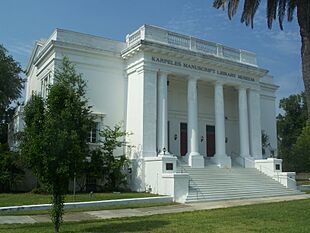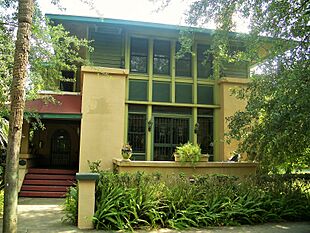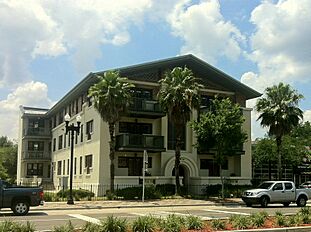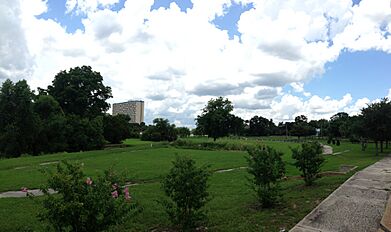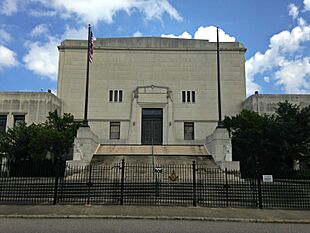Springfield (Jacksonville) facts for kids
Quick facts for kids
Springfield
|
|
|---|---|
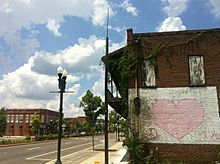
Main Street, near the intersection of 7th Street.
|
|
| Area | |
| • Total | 2.53 km2 (0.978 sq mi) |
| • Land | 2.53 km2 (0.978 sq mi) |
| Population
(2008)
|
|
| • Total | 4,674 |
| • Density | 1,845.2/km2 (4,779.1/sq mi) |
| ZIP Code |
32206
|
| Area code(s) | 904 |
| Website | myspringfield.org |
|
Springfield Historic District
|
|

Corner of Third and Pearl
|
|
| Location | Jacksonville, Florida, US |
| Built | 1880s through 1920s |
| Architectural style | Late 19th- and 20th-century revivals Prairie School Colonial Revival Queen Anne |
| NRHP reference No. | 86003640 |
| Added to NRHP | January 22, 1987 |
Springfield is a cool, historic neighborhood in Jacksonville, Florida, USA. It's just north of the city's downtown area. Springfield started way back in 1869. It grew a lot from the 1880s to the 1920s.
The Springfield Historic District is a special area. It's listed on the National Register of Historic Places. This means it's important for its history and amazing buildings. You can find some of the best examples of 19th and early 20th-century architecture here.
Contents
Exploring Springfield's Location
Springfield's borders are easy to spot. A creek called Hogan's Creek runs along its southern side. Railroad tracks are on the north and east. Boulevard Road marks the western edge. This road has shops and businesses next to the older homes.
How the Neighborhood is Laid Out
The historic part of Springfield has a grid pattern. This means streets run straight, like a checkerboard. Some streets go north and south and have names. Others go east and west and have numbers. Many blocks have alleys, which are narrow paths behind houses.
Some streets still have their original brick pavers. These are old bricks used for roads. You might also see granite curbstones. Most streets now have asphalt and concrete curbs. Sidewalks have old hexagonal pavers and newer concrete sections.
Trees and Old-Time Touches
Trees make the neighborhood look beautiful. Big oak trees are everywhere. You can also find cool old things scattered around. These include hitching posts for horses and fancy cast iron fences. There are also stone walls and carriage stepping stones. These items show how old the area is, going back to the turn of the 20th century.
Springfield's History
Springfield began as a place for homes in 1871. A person named John H. Norton started developing it. The neighborhood really started to grow around 1882. This was when the Springfield Development Company was formed. Growth sped up even more after a huge fire in 1901.
The Great Fire of 1901
The Great Fire of 1901 destroyed a big part of downtown Jacksonville. Many important and wealthy people lost their homes. The smoke from the fire was so thick it could be seen far away, even in North Carolina. The fire burned for eight hours. It destroyed 146 city blocks and 3,268 buildings. Seven people sadly lost their lives. After the fire, many people who lost their homes moved to Springfield.
Old Buildings and Styles
The buildings in the historic district were built from about 1885 to 1930. Most houses are made of wood. They are built in a simple, local style called vernacular. But you can also see some fancy styles from the late 1800s and early 1900s. These include Queen Anne, Colonial Revival, and the Stick style. Later, in the 20th century, styles like Prairie School, Bungalow, and Mediterranean became popular.
Springfield didn't have a big building boom in the 1920s. This is because most of the land was already taken. So, new buildings were only built on empty lots or where old buildings had been removed.
Springfield Today
In 2010, Southern Living magazine called Springfield the number one "comeback" neighborhood in the South. This means it had improved a lot over ten years. Florida Trend Magazine also wrote about Springfield in 2010. They said the neighborhood kept doing well, even when the housing market was slow.
Recently, more people have become interested in developing Springfield. In 2016 alone, two new breweries were announced. Also, two restaurants and a Walgreens pharmacy opened in the area.
Cool Features of Springfield
The Hogan's Creek Park System is one of the best parts of Springfield. These old parks and structures are on the southern edge of the neighborhood. They cover about 30.91 acres. This is about five percent of Springfield's total land.
Parks and Architecture
Klutho Park is a large park, covering 17.47 acres. Springfield Park is another park, about 8.3 acres. Along the creek, you can see stone railings and bridges. These were designed by Henry John Klutho in 1929. Klutho was a very important architect in Jacksonville in the early 1900s. He was a big supporter of the Prairie School style. The house he designed for himself in Springfield was said to be the first in Florida to use "modernist" architecture.
Most buildings in Springfield are wooden homes. There are fewer brick or stone buildings for businesses, churches, schools, and community centers. Many of the wooden buildings are two stories tall. They often have a gable or hip roof. Most still have their original wood siding or shingles. Some houses have had new siding like aluminum or vinyl added.
Porches and Windows
One-story porches are common. Some houses even have porches on both the first and second floors. You'll see different types of windows, like sash and casement windows. Brick or stucco buildings are usually one or two stories tall. Most of these are shops with big glass windows. They usually don't have much decoration. Their roofs are often flat with a raised wall on the front.
What Makes Springfield Special
You can find some shops and factories near the railroad lines on the north and east sides of Springfield. There are also a few shops scattered inside the neighborhood. Schools, churches, apartment buildings, and parks are all over the area. Even though some modern buildings have popped up, they haven't taken over the old feel of Springfield. The residential areas are mostly the same, with not many new buildings built after 1930.
Most of the buildings in the historic district are at least 50 years old. They still look much like they did originally. This helps show the history of the area. About 95 percent of all buildings in the district are considered "contributing." This means they add to the historic character. The other five percent are either newer or have changed too much from their original look.
Gallery



